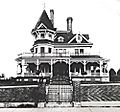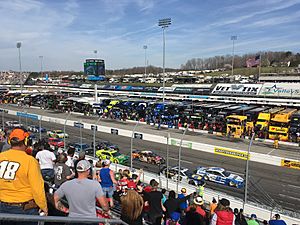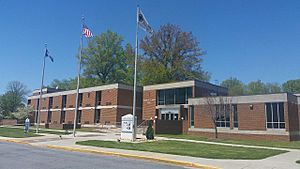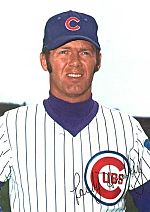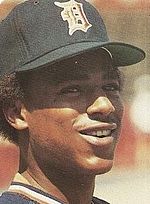Martinsville, Virginia facts for kids
Quick facts for kids
Martinsville, Virginia
|
||
|---|---|---|
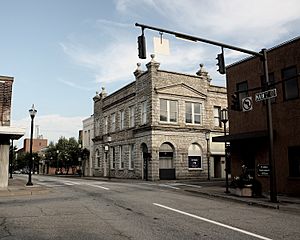
Martinsville's uptown district.
|
||
|
||
| Nickname(s):
M-Ville, The 276
|
||
| Motto(s):
A City Without Limits
|
||
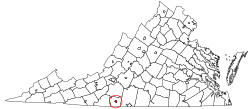 |
||
| Country | ||
| State | ||
| County | None (Independent city) | |
| Founded | 1791 | |
| Incorporated (town) | 1873 | |
| Incorporated (city) | 1929 | |
| Named for | Joseph Martin | |
| Government | ||
| • Type | Council-manager | |
| Area | ||
| • Total | 11.01 sq mi (28.51 km2) | |
| • Land | 10.96 sq mi (28.37 km2) | |
| • Water | 0.05 sq mi (0.14 km2) | |
| Elevation | 1,017 ft (310 m) | |
| Population
(2020)
|
||
| • Total | 13,485 | |
| • Density | 1,224.8/sq mi (472.99/km2) | |
| Time zone | UTC−5 (Eastern (EST)) | |
| • Summer (DST) | UTC−4 (EDT) | |
| ZIP codes |
24112-24115
|
|
| Area code(s) | 276 | |
| FIPS code | 51-49784 | |
| GNIS feature ID | 1498514 | |
| Website | http://www.martinsville-va.gov | |
Martinsville is an independent city in the Commonwealth of Virginia. As of the 2020 census, the population was 13,485. Located in both Southside and Southwest Virginia, it is the county seat of Henry County, although the two are separate jurisdictions. The Bureau of Economic Analysis combines the city of Martinsville with Henry County for statistical purposes.
Martinsville is the principal city of the Martinsville Micropolitan Statistical Area, with a population of 73,346 as of the 2000 census.
The paper clip-shaped Martinsville Speedway, the shortest track in the NASCAR Cup Series at 0.526 miles (847 m) and one of the first paved "speedways", is located just outside the city near the town of Ridgeway.
Contents
History
Martinsville was founded by American Revolutionary War General, Indian agent and explorer Joseph Martin, born in Albemarle County. He developed his plantation Scuffle Hill on the banks of the Smith River near the present-day southern city limits. General Martin and revolutionary patriot Patrick Henry, who lived briefly in Henry County and for whom the county is named, were good friends.
The city's chief industry for many early years was the manufacture of plug chewing tobacco. The Henry County area became known as the "plug tobacco capital of the world." In the wake of the collapse of the plantation economy following the American Civil War, the local economy was reeling. Stepping into the breach were several thriving plug firms which sold their merchandise across the nation beginning in the nineteenth century.
Local families were heavily involved in these companies, bestowing their names on them and reaping sizeable profits until the early twentieth century, when the tobacco monopolies created by R.J. Reynolds and James Buchanan Duke bought out most firms. (In most cases, in bold anti-competitive moves, the two tobacco titans simply shut down their acquisitions overnight. These actions resulted in a U.S. government lawsuit against American Tobacco Company.) Among the earliest of these firms were D.H. Spencer & Sons and Spencer Bros. Other families soon joined in founding other early firms, including the Gravelys, the Comptons, the Ruckers, the Wittens, the Lesters and the Browns.
The city's main industry for a century was furniture construction, and today Virginia furniture makers still reside in the region. Martinsville declared itself an independent city in 1928, while retaining its status as county seat. (In the 21st century however, it is a county seat in name only, as all of Henry County's administrative and judicial functions are carried out from the administration building and courthouse in nearby Collinsville.)
DuPont in 1941 built a large manufacturing plant for producing textile nylon filament, a vital war material. During the Cold War, the city was identified as a target for strategic bombing by the Soviet Union. This nylon production jump-started the growth of the textiles industry in the area. For several years Martinsville was known as the "Sweatshirt Capital of the World."
Business leaders in the mid-20th century, like Whitney Shumate, worked to improve sub-standard housing in Martinsville. He helped clear out a portion of Martinsville called "Mill Town", which had sub-standard rental housing originally provided in the 19th century for the defunct cotton mill employees. New homes were constructed in the neighborhood, built with sound materials and with all city services for the first time. What had originally been considered a depressed civic area rapidly became a center of progress as middle class blacks finally began to prosper. As an editorial in the local newspaper noted, "One of the projects which won him considerable attention and praise was the instigation of the redevelopment of what was once known as Martinsville Cotton Mill Village. He and associates purchased about 50 houses in North Martinsville, and using private capital rather than federal aid, rebuilt them into comfortably inhabitable homes, making it possible for many persons to purchase homes within their financial range."
In the early 1990s, changing global economic conditions and new trade treaties made Martinsville textiles and furniture manufacturing economically unsustainable. Many firms closed shop and laid off thousands of workers; the production moved offshore to other countries. The city is repositioning itself long-term as a center for technology development and manufacturing. Due to the local government's inability to fund certain services, in the near future the city of Martinsville may decide to legally convert into the town of Martinsville.
MZM, Inc. opened a facility in Martinsville as part of the Cunningham scandal.
The Martinsville City School District has Martinsville High School, which averages about 900 students. The Martinsville City Public Schools system has 1 high school, 1 middle school, 2 elementary schools, and 1 preschool.
Additionally, there is a private P.S.-12 school near Martinsville in Henry County, Carlisle School. The school serves approximately 600 students, about 130 of them high school students.
Martinsville is also home to the Virginia Museum of Natural History, an affiliate of the Smithsonian Institution. It was founded by Martinsville native Dr. Noel Boaz, and Piedmont Arts Association, a nonprofit art museum and affiliate of the Virginia Museum of Fine Arts.
Memorial Hospital of Martinsville serves the greater Martinsville and Henry County area. The earliest local hospital was the 50-bed Shackelford Hospital, founded by Dr. Jesse Martin Shackelford, who was later joined by surgeon son Dr. John Armstrong Shackelford, an early graduate of Johns Hopkins University School of Medicine. Founder of the Hospital Association of Virginia, Dr. Jesse Shackelford was an early advocate of comprehensive care for state citizens. Shackelford Hospital was sold in 1946, and Martinsville General Hospital subsequently opened with Dr. John Shackelford as its first chief surgeon. In 1970 Memorial Hospital of Martinsville opened its doors, replacing Martinsville General.
The Beaver Creek Plantation, John Waddey Carter House, Dry Bridge School, East Church Street-Starling Avenue Historic District, Fayette Street Historic District, Little Post Office, Martinsville Fish Dam, Martinsville Historic District, Martinsville Novelty Corporation Factory, and Scuffle Hill are listed on the National Register of Historic Places.
Liberty Fair Mall opened in 1989.
Geography
According to the United States Census Bureau, the city has a total area of 11.0 square miles (28.5 km2), of which 11.0 square miles (28.5 km2) is land and 0.1 square miles (0.3 km2) (0.5%) is water. The north side of the city has the highest average elevation. The east side slopes gradually down to the Smith River on the south side. The west side is hilly.
Demographics
| Historical population | |||
|---|---|---|---|
| Census | Pop. | %± | |
| 1880 | 289 | — | |
| 1900 | 2,384 | — | |
| 1910 | 3,368 | 41.3% | |
| 1920 | 4,075 | 21.0% | |
| 1930 | 7,705 | 89.1% | |
| 1940 | 10,080 | 30.8% | |
| 1950 | 17,251 | 71.1% | |
| 1960 | 18,798 | 9.0% | |
| 1970 | 19,653 | 4.5% | |
| 1980 | 18,149 | −7.7% | |
| 1990 | 16,162 | −10.9% | |
| 2000 | 15,416 | −4.6% | |
| 2010 | 13,821 | −10.3% | |
| 2020 | 13,485 | −2.4% | |
| U.S. Decennial Census 1790-1960 1900-1990 1990-2000 2010-2020 |
|||
2020 census
| Race / Ethnicity | Pop 2010 | Pop 2020 | % 2010 | % 2020 |
|---|---|---|---|---|
| White alone (NH) | 6,707 | 5,732 | 48.53% | 42.51% |
| Black or African American alone (NH) | 6,191 | 6,043 | 44.79% | 44.81% |
| Native American or Alaska Native alone (NH) | 18 | 23 | 0.13% | 0.17% |
| Asian alone (NH) | 127 | 116 | 0.92% | 0.86% |
| Pacific Islander alone (NH) | 0 | 4 | 0.00% | 0.03% |
| Some Other Race alone (NH) | 10 | 46 | 0.07% | 0.34% |
| Mixed Race/Multi-Racial (NH) | 216 | 496 | 1.56% | 3.68% |
| Hispanic or Latino (any race) | 552 | 1,025 | 3.99% | 7.60% |
| Total | 13,821 | 13,485 | 100.00% | 100.00% |
Note: the US Census treats Hispanic/Latino as an ethnic category. This table excludes Latinos from the racial categories and assigns them to a separate category. Hispanics/Latinos can be of any race.
2010 Census
As of the census of 2010, there were 13,821 people, 6,498 households, and 4,022 families residing in the city. The population density was 1,407.1 people per square mile (543.1/km2). There were 7,249 housing units at an average density of 661.7 per square mile (255.4/km2). The racial makeup of the city was 48.38% White, 45.45% African American, 0.10% Native American, 0.47% Asian, 0.69% from other races, and 0.81% from two or more races. Hispanics or Latinos of any race were 5.70% of the population.
There were 6,498 households, out of which 26.3% had children under the age of 18 living with them, 39.0% were married couples living together, 19.1% had a female householder with no husband present, and 38.1% were non-families. 34.2% of all households were made up of individuals, and 15.4% had someone living alone who was 65 years of age or older. The average household size was 2.27 and the average family size was 2.89.
The age distribution was 22.6% under the age of 18, 7.0% from 18 to 24, 26.7% from 25 to 44, 23.2% from 45 to 64, and 20.6% who were 65 years of age or older. The median age was 41 years. For every 100 females, there were 82.4 males. For every 100 females age 18 and over, there were 78.4 males.
The median income for a household in the city was $27,441, and the median income for a family was $35,321. Males had a median income of $28,530 versus $21,367 for females. The per capita income for the city was $17,251. About 14.0% of families and 19.2% of the population were below the poverty line, including 25.6% of those under age 18 and 16.9% of those age 65 or over. As of August 2010, the city's unemployment rate stood at 20 percent.
Culture
Sports
Martinsville is home to the Martinsville Mustangs of the Coastal Plain League, a collegiate summer baseball league. The Mustangs play at Hooker Field in Martinsville. The Mustangs began play for the league's 2005 season.
Martinsville is also home to Martinsville Speedway, which opened in 1947. The NASCAR Sprint Cup Series hosts two races there every year.
Gallery
-
General Joseph Martin (1740–1808), born Albemarle County, Virginia, died Henry County, Virginia
Economy
The city's chief industry for many early years was the manufacture of plug chewing tobacco. The Henry County area became known as the "plug tobacco capital of the world". In the wake of the collapse of the plantation economy following the American Civil War, the local economy was reeling. Stepping into the breach were several thriving plug firms which sold their merchandise across the nation beginning in the nineteenth century.
Local families were heavily involved in these companies, bestowing their names on them and reaping sizeable profits until the early twentieth century, when the tobacco monopolies created by R.J. Reynolds and James Buchanan Duke bought out most firms. (In most cases, in bold anti-competitive moves, the two tobacco titans simply shut down their acquisitions overnight. These actions resulted in a U.S. government lawsuit against American Tobacco Company.) Among the earliest of these firms were D.H. Spencer & Sons and Spencer Bros. Other families soon joined in founding other early firms, including the Gravelys, the Comptons, the Ruckers, the Wittens, the Lesters and the Browns.
The city's main industry for a century was furniture construction, and today Virginia furniture makers still reside in the region.
On October 28, 2021, it was announced the Colorado based apparel and footwear company VF Corporation will continue to expand in Martinsville creating 82 new jobs, while investing $10 million dollars into the area.
Sports
Martinsville is home to the Martinsville Mustangs of the Coastal Plain League, a collegiate summer baseball league. The Mustangs play at Hooker Field in Martinsville. The Mustangs began play for the league's 2005 season.
The Martinsville area is also home to Martinsville Speedway, which opened in 1947. The NASCAR Cup Series and NASCAR Xfinity Series hosts two races there every year while the NASCAR Camping World Truck Series hosts one race there every year. The speedway also host the NASCAR Whelen All-American Series.
Education
The city is served by the Martinsville City Public Schools. There are five public schools in Martinsville:
- Martinsville High School, opened in 1968 and serves roughly 580 students in grades 9-12.
- Martinsville Middle School, originally built as a high school in 1939 and serves roughly 430 students in grades 6–8.
- Albert Harris Elementary School, opened as a high school in 1958 and now serves roughly 490 students in kindergarten through fifth grade. The school is named after Albert Harris, an African-American minister who was a key advocate for the education of local African-American children.
- Patrick Henry Elementary School, opened in 1950 and serves roughly 435 students in kindergarten through fifth grade. The school is named after founding father Patrick Henry.
- Clearview Early Childhood Center, opened as an elementary school in 1954 and now serves roughly 140 students in preschool as part of the Virginia Preschool Initiative.
The city is also home to the K-12 private school, Carlisle School. The school serves approximately 400 students, about 130 of them are high school students. The School was established in 1968
Colleges and universities in Martinsville include the New College Institute and Patrick & Henry Community College, where students can also take satellite courses through Old Dominion University.
Transportation
The Piedmont Area Regional Transit (PART) operates and serves the city of Martinsville. Routes include parts of both martinsville and Henry county. The Blue Ridge Airport is used for general aviation and is located 9 miles (14 km) outside the city.
Notable people
- Buddy Arrington – former NASCAR driver
- Rabih Abdullah – National Football League player
- John Robert Brown – US House of Representatives
- Thomas G. Burch – American farmer, tobacco manufacturer, and politician (US House of Representatives and US Senate)
- Greg Gaines – National Football League player
- Tony Gravely – UFC Fighter
- Clinton Gregory - country singer and fiddle player
- Carl Hairston – National Football League player
- George Hairston plantation owner, former sheriff of Henry County, Brigadier General, War of 1812
- Robert Hairston plantation owner, former sheriff of Henry County, captain of militia, French and Indian War
- Jeremy O. Harris- Actor and playwright
- Patrick Henry – American patriot (resided at Leatherwood Plantation, Henry County, outside current city limits)
- Odell Hodge – played college basketball at Old Dominion University and former professional basketball player
- Randy Hundley – former Major League Baseball player & coach; former all-star and Gold Glove winner
- Todd Hundley – former Major League Baseball player, 2x All-star
- Hodgetwins – stand-up comedians
- Magdalen Hsu-Li – American singer-songwriter, painter, speaker, poet, and activist
- George Hairston Jamerson, Brigadier general during World War I
- Kristen-Paige Madonia – Novelist and creative writing teacher
- General Joseph Martin – American Revolutionary War general, explorer, legislator, Indian agent
- Delvin Joyce – National Football League player
- Barry Michaels – American radio personality
- Thon Maker - 10th pick in the 2016 NBA Draft, NBA player for Milwaukee Bucks
- Matur Maker - professional basketball player
- Shawn Moore – National Football League and Canadian Football League player
- Jesse Penn – National Football League player
- Nancy Redd – Author and former Miss Virginia
- Jessamine Shumate – artist, painter
- Whitney Shumate - businessman, developer
- Gregory Swanson-though born in Danville, Va. Practiced law in Martinsville until 1957
- General Dennis L. Via - former Commanding General of the United States Army Materiel Command (AMC)
- Sonny Wade – Canadian Football League player
- "Sweet Lou" Whitaker—Major League Baseball player
- Stafford G. Whittle – Judge, Virginia Supreme Court of Appeals
- Kennon C. Whittle – Judge, Virginia Supreme Court of Appeals
- Red Top Young – Blues, rhythm and blues, country, rock & roll, and jazz musician
See also
 In Spanish: Martinsville (Virginia) para niños
In Spanish: Martinsville (Virginia) para niños



